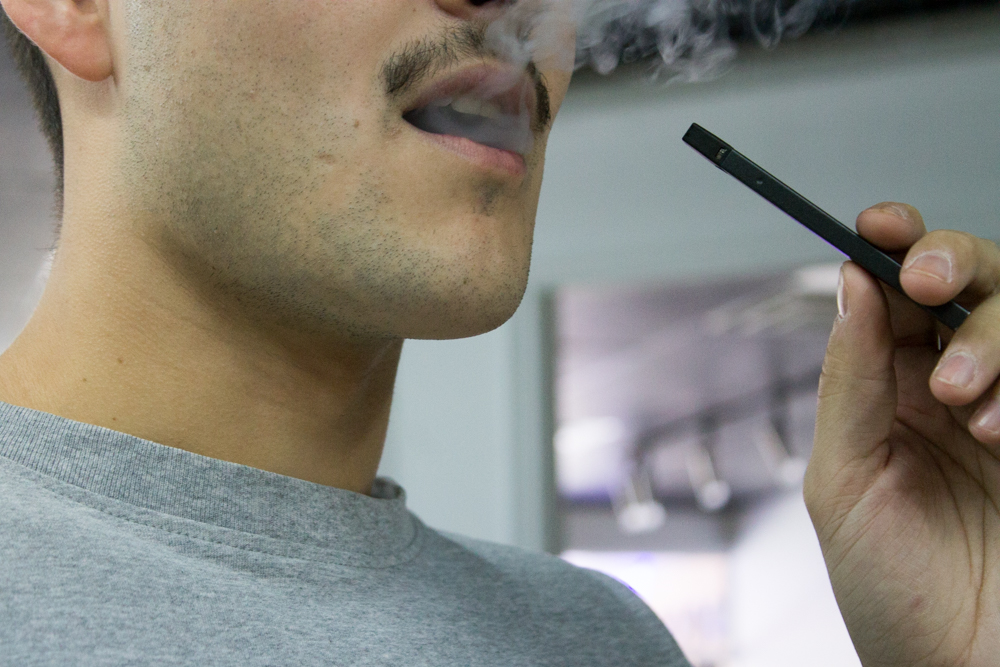In a puff of smoke, vaping has become a worldwide phenomenon. As more dimly-lit electronic cigarette stores set up shop across Montreal, Concordia University Health and Exercise Science masters students, Tasfia Tasbih and Florent Larue, aim to demystify the consequences of using e-cigarettes.
“People have the notion that [an e-cigarette] is really safe and that it’s not harmful like a regular cigarette, but it actually is,” Tasbih said. “Any amount of nicotine consumed is harmful. Smokers may not feel the impact today, but what I have found is that these products will gradually drag you toward addiction and different negative physiological responses.”
Some users misguidedly believe that vaping is more effective than conventional treatments to stop smoking altogether. However, there is no evidence of its harmlessness. The World Health Organization has consistently called for a regulation of e-cigarettes because of the lack of literature, and this past June, San Francisco became the first U.S. city to ban the sale and distribution of e-cigarettes.
According to Tasbih and Larue, e-cigarettes are often promoted as being healthier because companies deceptively claim that they do not contain nicotine.
“More and more people are nowadays choosing electronic cigarettes to reduce their combustible cigarette consumption, unaware of the lack of knowledge we have about this device,” Larue said.
What makes e-cigarettes so appealing is that, unlike a traditional cigarette, as battery-powered vaporizers, they are more easily concealed than their tobacco-rolled counterpart. In 2018, the value of e-cigarettes was estimated at $15 billion worldwide, and their popularity continues to grow. In an attempt to attract more clients, companies have produced vapes in a variety of colours, sizes and designs, allowing users to customize their experience.
E-cigarette companies have also received backlash for developing different fruity flavours for vape juice, also referred to as “e-juice” or “e-liquid.” This juice is the fluid used in vaporizers to create vapour and varies in nicotine levels. Flavours available include peppermint, strawberry and raspberry, which are especially popular among younger clients.
While researchers have shown that using e-cigarettes leads to reduced respiratory function, Tasbih and Larue hope to take their work a step further. Over the course of their three-year project, the two graduate students will study how to approach smoking cessation treatment, as well as the impacts of e-cigarette consumption, according to sex differences.
For Larue, the research project is a way for he and his colleagues to confirm the impact of e-cigarettes on the autonomic nervous system’s stress response.
The research team, supervised by Dr. Simon Bacon, has already begun recruiting participants. Throughout the project, Tasbih and Larue plan to study 120 participants between the ages of 18 and 45 who don’t have chronic diseases. Ninety will be either e-cigarette or traditional cigarette smokers, and the remaining ones will be non-smokers.
Yet, conducting the pioneering study has presented its fair share of challenges. Although there are many ways to measure the autonomic nervous system, they are not easily feasible. Over the course of their work, Larue admits that he and his colleagues sometimes struggled to obtain a good signal to perform impedance cardiography assessments.
“One of the many [challenges] is to screen people with no smoking history and no underlying disease, to make sure that the effects we will see aren’t linked to something other than e-cig smoking,” Larue said. “We also have to be precise in our measurements since physiological changes observed can be small, but when lasting for years, they could still become meaningful or harmful.”
Photo by Britanny Clarke
